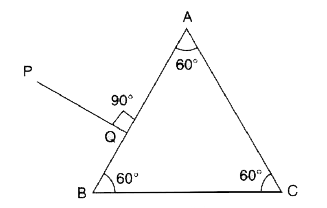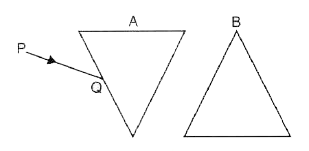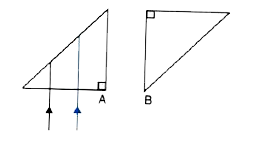Figure below shows a light ray of green colour incident on the prisms A,B and C. in each case, draw the path of the ray of light as it enters and emergest out of the prism. Mark the angle wherever necessary.

The completed diagrams are given in figure.

Topper's Solved these Questions
- REFRACTION OF LIGHT AT PLANE SURFACESBook:ICSEChapter:REFRACTION OF LIGHT AT PLANE SURFACESExercise:EXERCISE-4(A)
Explore 31 Videos
- REFRACTION OF LIGHT AT PLANE SURFACESBook:ICSEChapter:REFRACTION OF LIGHT AT PLANE SURFACESExercise:EXERCISE-4(A) MULTIPLE CHOICE TYPE
Explore 3 Videos
- REFRACTION OF LIGHTBook:ICSEChapter:REFRACTION OF LIGHTExercise:DIAGRAM BASED MCQ:
Explore 5 Videos
- REFRACTION THROUGH A LENS Book:ICSEChapter:REFRACTION THROUGH A LENS Exercise:EXERCISE-5(D) (MULTIPLE CHOICE TYPE)
Explore 2 Videos
Similar Questions
In figure, a ray of light PQ is incident normally on the hypotenuse of an isosceles right angled prism ABC. (a) complete the path of the ray PQ till it emerges from the prism. Mark in the diagram the angle wherever necessary. (b) what is the angle of deviation of the ray PQ ?
(c) Name a device in which this action is used.

View SolutionThe diagram alongside shows a beam of light (red + blue) incident normally on an equilateral triangular prism. If the critical angle for the material of prüsm is 60∘ for the light of red colour, complete the diagram showing the path of light of each colour emerging out of the prism. Mark in the diagram the angles wherever necessary.

View SolutionA beam of white light is incident normally on the surface AB of an equilateral prism ABC and emerges out of it suffering a deviation of 60∘.
(a) Draw a diagram to show the path of beam till it emerges out of the prism. Mark the angles wherever necessary.
(b) What assumption have you made while drawing the diagram ?
(c) Name the phenomenon exhibited by the light beam.
View SolutionA beam of white light is incident normally on the surface AB of an equilateral prism ABC and emerges out of it suffering a deviation of 60∘.
(a) Draw a diagram to show the path of beam till it emerges out of the prism. Mark the angles wherever necessary.
(b) What assumption have you made while drawing the diagram ?
(c) Name the phenomenon exhibited by the light beam.
View SolutionA ray of green light enters a liquid from air, as shown in figure. Angle 1 is 45∘ and angle 2 is 30∘.

(a) Find the refractive index of the liquid
(b) Show in the diagram the path of the ray after it strikes the mirror and re-enters in air. mark in the diagram the angles wherever necessary.
(c) Redraw the diagram if plane mirror becomes normal to the refracted ray inside the liquid.
state the principle used.
View Solution
Copy the diagram given below and complete the path of the light ray till it emerges out of the prism. The critical angle of glass is 42∘. In your diagram mark the angles wherever necessary.
View SolutionFigure below shows two identical prisms A and B placed with their faces parallel to each other. A ray of light of single colour PQ is incident at the face of the prism A. complete the diagram to show the path of the ray till it emerges out of the prism B.

View SolutionFigure shows two identical prisms P and Q placed with their faces parallel to each other. A light ray AB of yellow colour is incident at the face of the prism P. Complete the diagram to show the path of the ray till it emerges out of the prism Q.

View Solution(a) Figure shows two isosceles right angled prisms A and B and the light rays incident on the prism A. complete the diagram to show the rays emerging out of the prism B.
(b) State the principle used for completing the ray diagram in part (a) above.

View SolutionFigure shows the section of a semi-circular glass slab having its centre at O. three rays of light A,B and C of the same colour are incident on the slab and strike on the edge XY at the point O. the light ray B suffers refraction along OB'.

(a) On the diagram, mark the critical angle by C.
(b) The rays enter the slab undeviated. give reason.
(c) Draw the path of rays A and C after they strike the edge XY.
(d) Name the phenomenon which the rays A and C exhibit.
View Solution

